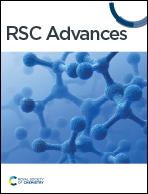Improved isoprene detection performance of Si-doped WO3 films deposited by sputtering and post-annealing†
Abstract
Si-doped WO3 films were sputtered at room temperature and then annealed in air at 500 °C. The Si doping resulted in structural distortion from space group P21/n to Pc. A high density of pores with a diameter of ∼20 nm was observed in the films, which is ideal for gas sensing applications because of the easy diffusion of gas. Isoprene sensitivity, which is defined as the resistance ratio measured in pure air and in air containing 5 ppm isoprene, was greatly improved by the Si doping. The films containing 6.3 at% Si showed the highest sensitivity of 7.7 at a working temperature of 325 °C. However, despite a lower sensitivity of 6.9 measured at 350 °C, the films exhibited better gas selectivity for isoprene over a range of reference gases, including methanol, ethanol, acetone, CO and CO2. The response and recovery times of the films were very short, being less than 1.5 and 3.0 seconds, respectively. Detailed characterization with a range of techniques verified that the increase in gas sensitivity in the Si-doped films was related to better oxygen adsorbability as a consequence of an increase in positively-charged oxygen vacancies introduced by the aliovalent substitution of W6+ by Si4+.



 Please wait while we load your content...
Please wait while we load your content...